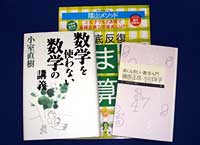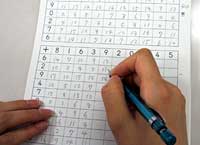|
|
|||||||
|
|
|||||||
|
|||||||
| | Web Japan >> | Trends in Japan >> | Lifestyle >> | Arithmetic for Adults | |
|
ARITHMETIC FOR ADULTS Books Persuade Readers that Math Can Be Fun (August 24, 2005) For many people, the word math tends to bring back unpleasant memories of hard-to-understand classes and low test scores at school. Despite this, the number of adults doing math for fun has been on the rise in recent years, and many people who used to dislike the subject when they studied it at school are now eagerly snapping up math-related books and other products. Their newfound enthusiasm stems in some cases from a desire to keep their brains in good working order. The Beauty of Numbers Initially, these books were a hit among company employees. Struggling to survive in a new work environment dominated by digital and computer technology, they reasoned that at the very least they should be able to solve mathematical problems. In 2003, however, a subtle change occurred in the math book market, sparked by the publication of Hakase no Aishita Sushiki (The Equation the Professor Loved), written by Akutagawa Prize-winning author Ogawa Yoko and published by Shinchosha Co. The success of the book led Ogawa to pen Yo ni mo Utsukushii Sugaku Nyumon (An Introduction to Exceedingly Beautiful Math), published by Chikuma Shobo Publishing Co., based on conversations with the mathematician and essayist Fujiwara Masahiko. As many of Ogawa's fans are female, Yo ni mo Utsukushii Sugaku Nyumon had the effect of drawing women into a genre of book that had previously been the preserve of businessmen. They were attracted not only to the book's intriguing title but to its cover, with its soft pink tones, and to the novelty of discussing the beauty of math. Sales of the book shot up, earning it a place in the top ten of pocket-paperback bestsellers. A number of other titles are also enjoying popularity, such as Sugaku o Tsukawanai Sugaku no Kogi (A Math Lesson that Doesn't Use Math), published by Wac Co., and Chokkan de Wakaru Sugaku (Math Understood Intuitively), published by Iwanami Shoten Publishers, and the succession of new works seems certain to continue. Without the pressure of tests, many adults find they actually enjoy the stimulation offered by sines, cosines, differential calculus, and integral calculus - concepts that may have caused them hours of frustration in their school days. Plans are now underway to make a movie out of Hakase no Aishita Sushiki, which will likely add further fuel to the math boom. Healthy Minds Meanwhile, Hyaku Masu Keisan (Hundred-Square Calculations), a method of learning through repetition conceived by Kageyama Hideo, an elementary school principal in Hiroshima Prefecture, is also in the spotlight as a way for adults to keep their minds sharp. Hundred-square calculations involve a 10-by-10 grid, which is filled in by adding, multiplying, or doing other calculations using the numbers at the top and side of the grid. A book titled Kageyama Hideo no No Ikiiki! Otona no Keisan Purinto (An Energized Brain with Kageyama Hideo: Math Worksheets for Adults), which features hundred-squares problems, was published by Shogakukan Inc., and computer software along these lines has also been developed. Against the backdrop of Japan's graying society, it seems likely that arithmetic will increasingly be seen as a pursuit not only for schoolchildren but also for adults keen to retain their mental sharpness as they grow older. Copyright (c) 2005 Web Japan. Edited by Japan Echo Inc. based on domestic Japanese news sources. Articles presented here are offered for reference purposes and do not necessarily represent the policy or views of the Japanese Government. |
STUDYING KYOTO FOR FUN (February 18, 2005) KEEPING SHARP (December 22, 2004) |
|
|




